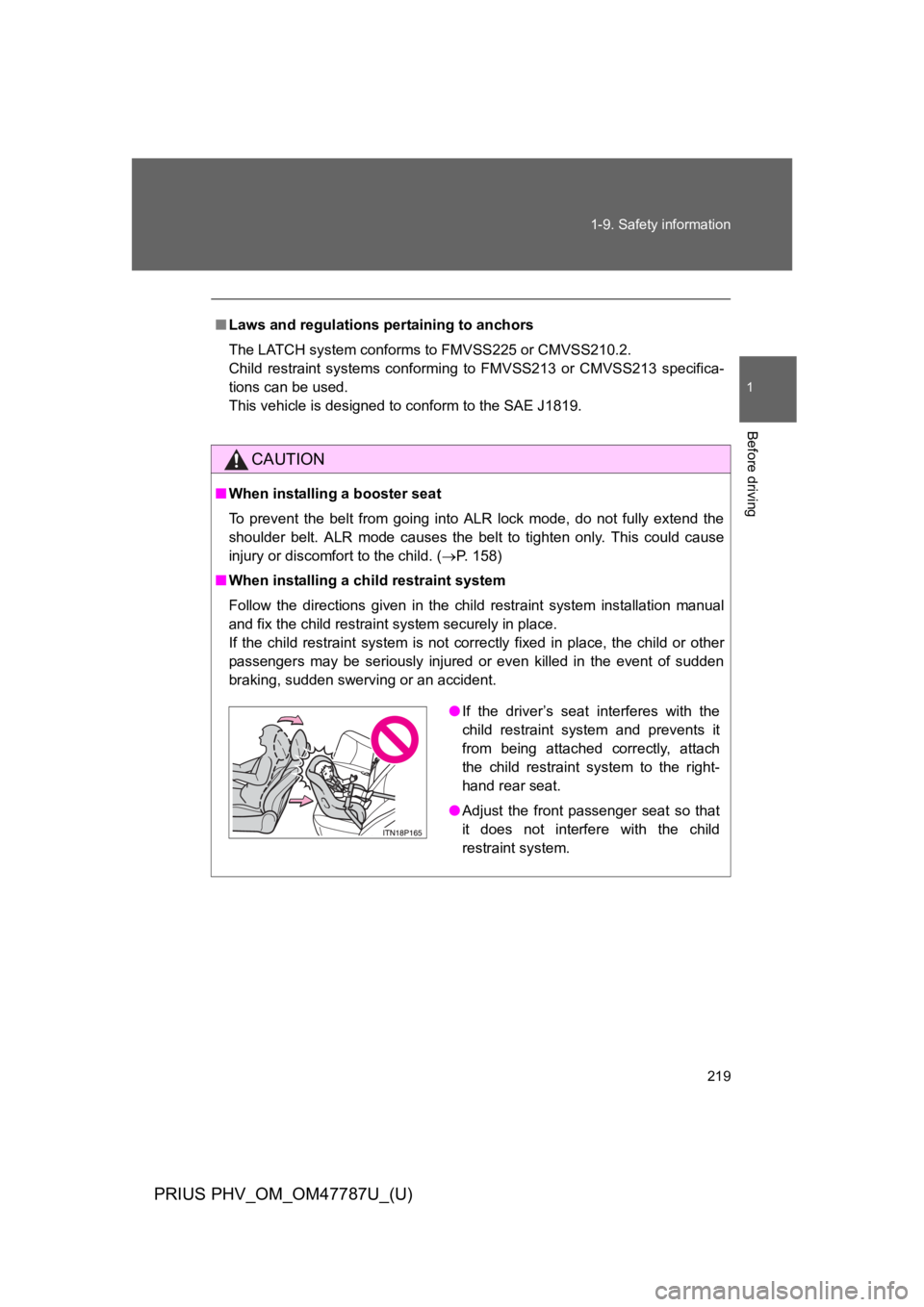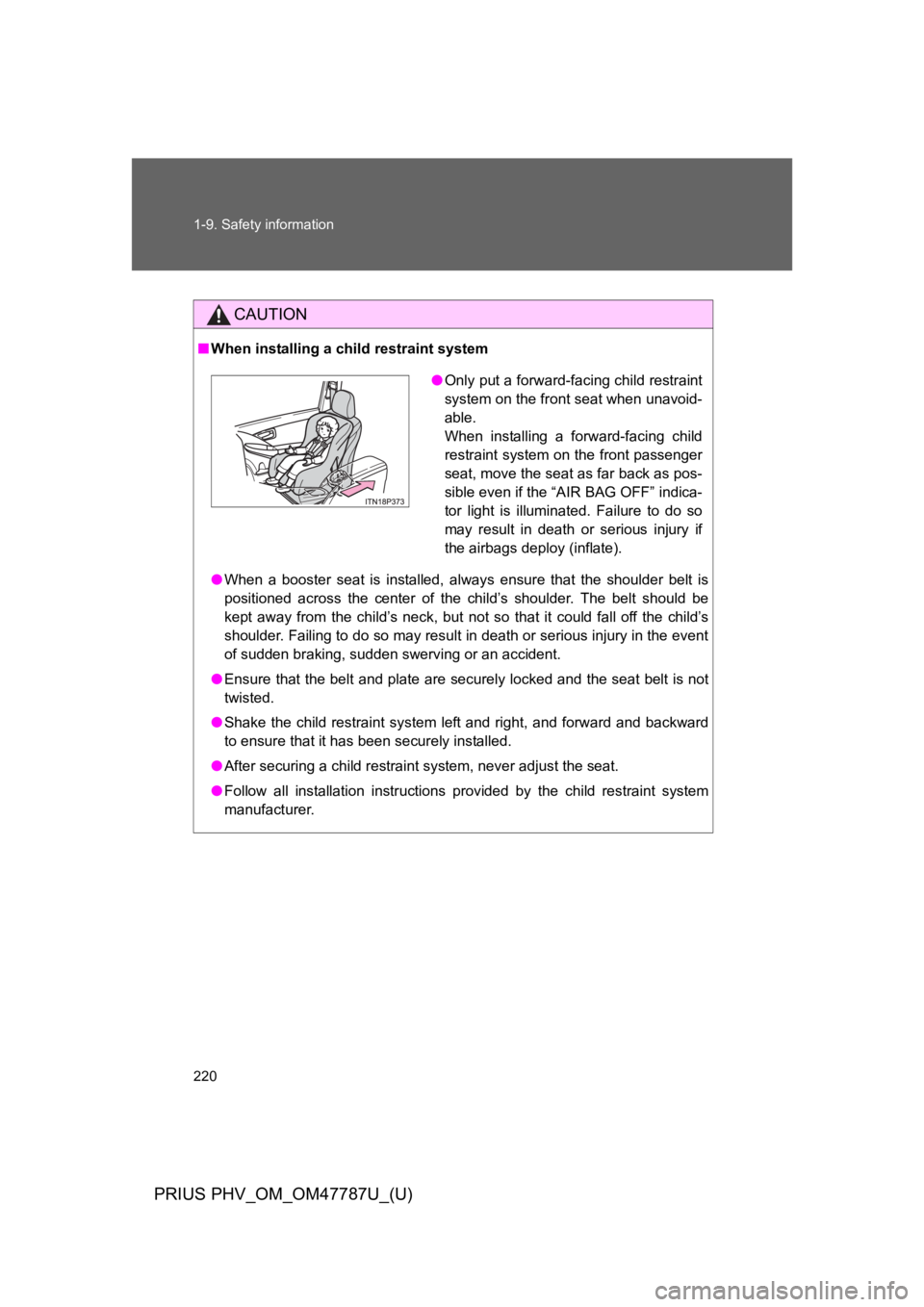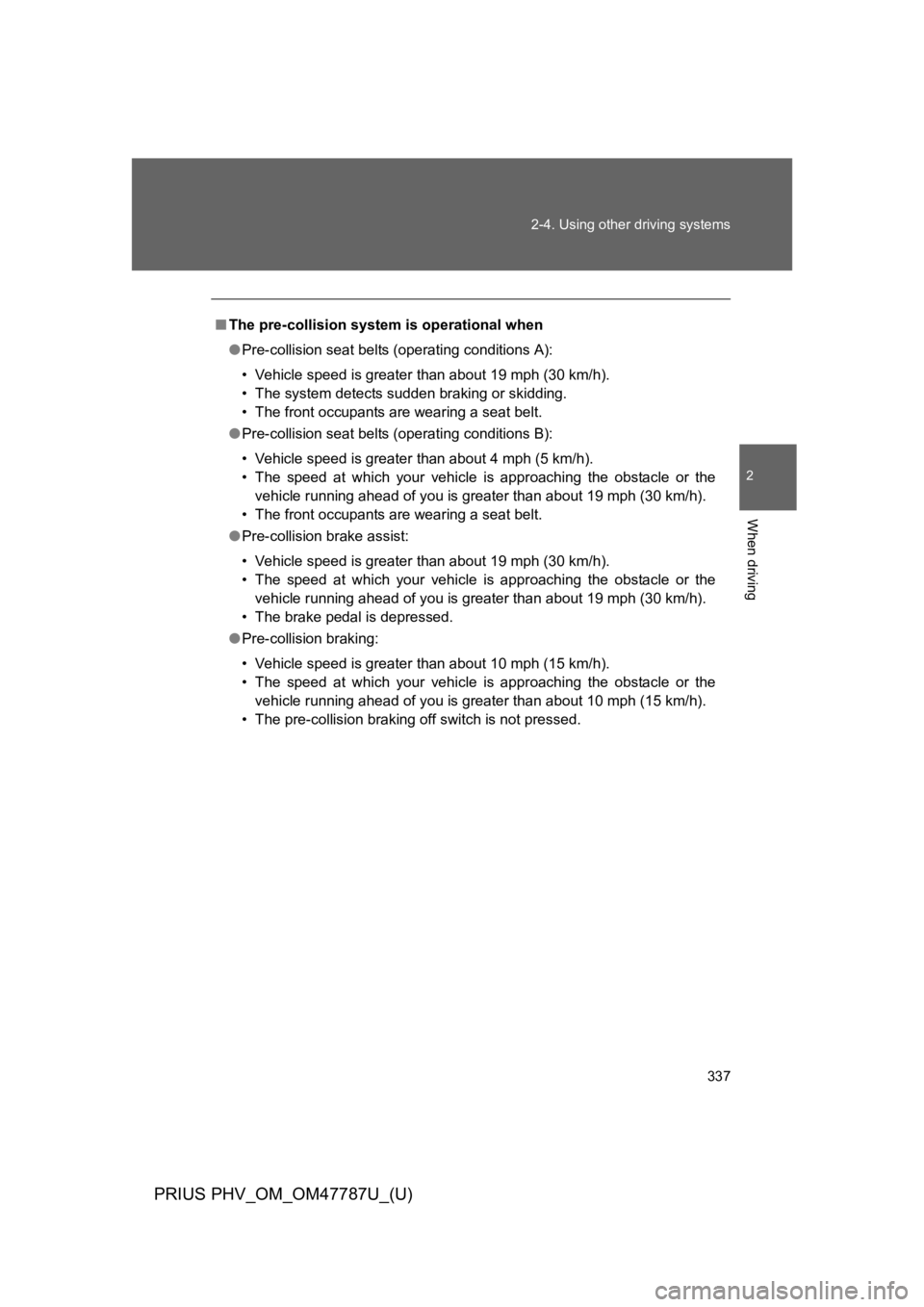Page 241 of 704
214
1-9. Safety information
PRIUS PHV_OM_OM47787U_(U)
Fully extend the shoulder belt
and then allow it to retract
slightly in order to activate the
ALR lock mode.
Lock mode allows the seat belt to
retract only.
While pushing the child restraint
system into the rear seat, allow
the shoulder belt to retract until
the child restraint system is
securely in place.
After the shoulder belt has
retracted to a point where there is
no slack in the belt, pull the belt to
check that it cannot be extended.
If the child restraint has a top tether strap, the top tether strap
should be latched onto the top tether strap anchor. (→P. 2 1 6 )
STEP 3
STEP 4
STEP 5
Page 242 of 704
215
1-9. Safety information
1
Before driving
PRIUS PHV_OM_OM47787U_(U)
■Booster seat
Place the child restraint system
on the seat facing the front of the
vehicle.
Sit the child in the child restraint
system. Fit the seat belt to the
child restraint system according
to the manufacturer’s instruc-
tions and insert the plate into the
buckle. Make sure that the belt is
not twisted.
Check that the shoulder belt is
correctly positioned over the
child’s shoulder and that the lap
belt is as low as possible.
(→P. 1 5 6 )
STEP 1
STEP 2
Page 243 of 704
216
1-9. Safety information
PRIUS PHV_OM_OM47787U_(U)
Removing a child restraint installed with a seat belt
Press the buckle release button
and fully retract the seat belt.
Child restraint systems with a top tether strap
Secure the child restraint system using a seat belt or the
LATCH anchors, and do the following.
Foldable type outside seats
Adjust the head restraint to the
upmost position.
STEP 1
Page 246 of 704

219
1-9. Safety information
1
Before driving
PRIUS PHV_OM_OM47787U_(U)
■Laws and regulations pertaining to anchors
The LATCH system conforms to FMVSS225 or CMVSS210.2.
Child restraint systems conforming to FMVSS213 or CMVSS213 specifica-
tions can be used.
This vehicle is designed to conform to the SAE J1819.
CAUTION
■When installing a booster seat
To p r e v e n t t h e b e l t f r o m g o i n g i n t o A L R l o c k m o d e , d o n o t f u l l y e x t e n d t h e
shoulder belt. ALR mode causes the belt to tighten only. This could cause
injury or discomfort to the child. (→P. 1 5 8 )
■When installing a child restraint system
Follow the directions given in the child restraint system installation manual
and fix the child restraint system securely in place.
If the child restraint system is not correctly fixed in place, the child or other
passengers may be seriously injured or even killed in the event of sudden
braking, sudden swerving or an accident.
●If the driver’s seat interferes with the
child restraint system and prevents it
from being attached correctly, attach
the child restraint system to the right-
hand rear seat.
●Adjust the front passenger seat so that
it does not interfere with the child
restraint system.
Page 247 of 704

220
1-9. Safety information
PRIUS PHV_OM_OM47787U_(U)
CAUTION
■When installing a child restraint system
●When a booster seat is installed, always ensure that the shoulder belt is
positioned across the center of the child’s shoulder. The belt should be
kept away from the child’s neck, but not so that it could fall off the child’s
shoulder. Failing to do so may result in death or serious injury in the event
of sudden braking, sudden swerving or an accident.
●Ensure that the belt and plate are securely locked and the seat belt is not
twisted.
●Shake the child restraint system left and right, and forward and backward
to ensure that it has been securely installed.
●After securing a child restraint system, never adjust the seat.
●Follow all installation instructions provided by the child restraint system
manufacturer.
●Only put a forward-facing child restraint
system on the front seat when unavoid-
able.
When installing a forward-facing child
restraint system on the front passenger
seat, move the seat as far back as pos-
sible even if the “AIR BAG OFF” indica-
tor light is illuminated. Failure to do so
may result in death or serious injury if
the airbags deploy (inflate).
Page 248 of 704
221
1-9. Safety information
1
Before driving
PRIUS PHV_OM_OM47787U_(U)
CAUTION
■Do not use a seat belt extender
If a seat belt extender is used when installing a child restraint system, the
seat belt will not securely hold the child restraint system, which could cause
death or serious injury to the child or other passengers in the event of sud-
den braking, sudden swerving or an accident.
■To c o r r e c t l y a t ta c h a c h i l d restraint system to the anchors
When using the LATCH anchors, be sure that there are no foreign objects
around the anchors and that the seat belt is not caught behind the child
restraint system. Make sure the child restraint system is securely attached,
or it may cause death or serious injury to the child or other passengers in the
event of a sudden braking, sudden swerve or accident.
Page 361 of 704

335
2-4. Using other driving systems
PRIUS PHV_OM_OM47787U_(U)
2
When driving
PCS (Pre-Collision System)∗
∗: If equipped
When the radar sensor detects possibility of a frontal collision, the
pre-collision systems such as the brakes and seat belts are automat-
ically engaged to lessen impact as well as vehicle damage.
■Pre-collision seat belts (front seat belts only)
If the pre-collision sensor detects that a collision is unavoidable, the
pre-collision system will retract the seat belt before the collision occurs.
The same will happen if the driver makes an emergency braking or
loses control of the vehicle. (→P. 1 5 8 )
However, when the VSC system is disabled, the system will not oper-
ate in the event of skidding.
■Pre-collision brake assist
When there is a high possibility of a frontal collision, the system applies
greater braking force in relation to how strongly the brake pedal is
depressed.
■Pre-collision braking
When there is a high possibility of a frontal collision, the system warns
the driver using a warning light, warning display and buzzer. If the sys-
tem determines that a collision is unavoidable, the brakes are automat-
ically applied to reduce the collision speed. Pre-collision braking can be
disabled using the pre-collision braking off switch.
Page 363 of 704

337
2-4. Using other driving systems
PRIUS PHV_OM_OM47787U_(U)
2
When driving
■The pre-collision system is operational when
●Pre-collision seat belts (operating conditions A):
•Vehicle speed is greater than about 19 mph (30 km/h).
•The system detects sudden braking or skidding.
•The front occupants are wearing a seat belt.
●Pre-collision seat belts (operating conditions B):
•Vehicle speed is greater than about 4 mph (5 km/h).
•The speed at which your vehicle is approaching the obstacle or the
vehicle running ahead of you is greater than about 19 mph (30 km/h).
•The front occupants are wearing a seat belt.
●Pre-collision brake assist:
•Vehicle speed is greater than about 19 mph (30 km/h).
•The speed at which your vehicle is approaching the obstacle or the
vehicle running ahead of you is greater than about 19 mph (30 km/h).
•The brake pedal is depressed.
●Pre-collision braking:
•Vehicle speed is greater than about 10 mph (15 km/h).
•The speed at which your vehicle is approaching the obstacle or the
vehicle running ahead of you is greater than about 10 mph (15 km/h).
•The pre-collision braking off switch is not pressed.